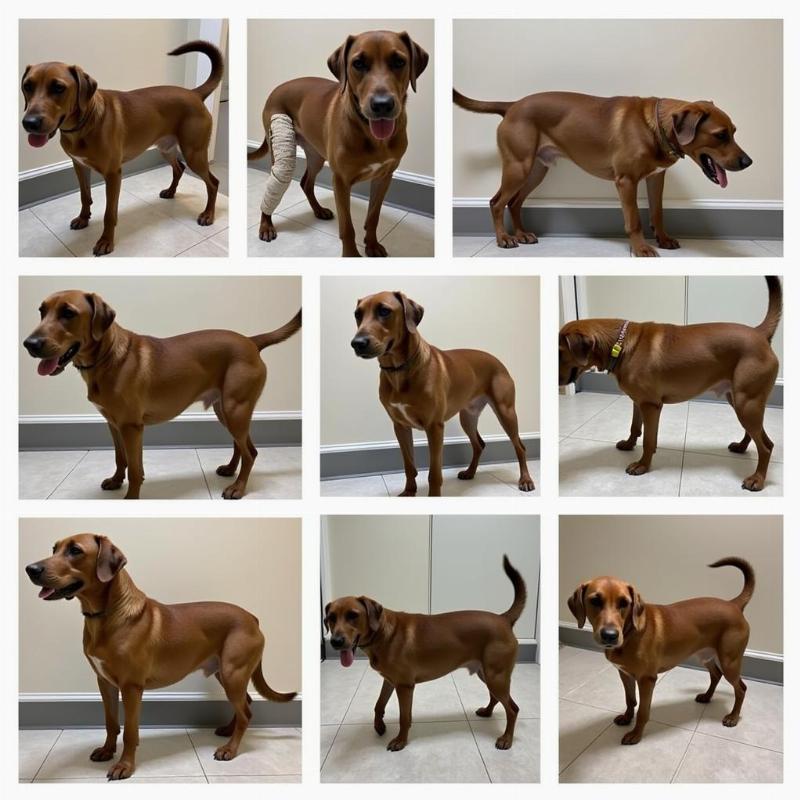Choosing between an ACL brace and surgery for your dog can be a tough decision. Both options address a torn Cranial Cruciate Ligament (CCL), a common injury in dogs equivalent to an ACL tear in humans. This article will help you navigate this crucial decision, weighing the pros and cons of each approach and providing the information you need to make the best choice for your furry friend. Ultimately, the best path depends on several factors, including your dog’s breed, size, age, activity level, and overall health.
Understanding CCL Tears in Dogs
CCL tears are painful and can significantly limit your dog’s mobility. The CCL stabilizes the knee joint, and a tear can cause instability and lead to arthritis if left untreated. While smaller dogs sometimes manage with conservative treatment and bracing, larger dogs often require surgery for a complete recovery.
Dog ACL Brace: A Non-Surgical Option
An ACL brace provides external support to the knee joint, helping to stabilize it and reduce pain. It’s a non-invasive option that can be beneficial for certain dogs, especially those who are not good candidates for surgery due to age or other health concerns. Braces can also be helpful for managing post-surgical recovery.
Benefits of an ACL Brace
- Non-invasive: Avoids the risks and recovery time associated with surgery.
- Less expensive: Braces are generally less costly than surgery.
- Manageable for some dogs: Can provide adequate support for small dogs or those with partial tears.
- Post-surgical support: Aids in recovery and reduces the risk of re-injury after surgery.
Drawbacks of an ACL Brace
- Not a permanent fix: The brace only manages the symptoms, not the underlying tear.
- Requires consistent use: The brace must be worn frequently and correctly for optimal effectiveness.
- Can be uncomfortable: Some dogs may find the brace restrictive or irritating.
- Not suitable for all dogs: Larger or highly active dogs may not benefit from bracing alone.
Dog ACL Surgery: A More Definitive Solution
Surgical intervention is often the recommended course of action for CCL tears, especially in larger breeds. Several surgical techniques exist, each aiming to stabilize the knee joint and restore normal function.
Benefits of ACL Surgery
- Addresses the underlying issue: Repairs the torn ligament and restores stability to the knee.
- Higher success rate: Generally leads to better long-term outcomes, especially for larger dogs.
- Improved mobility: Allows for a fuller return to normal activity levels.
- Reduces arthritis risk: By stabilizing the joint, surgery can minimize the development of arthritis.
Drawbacks of ACL Surgery
- Invasive procedure: Carries inherent risks associated with anesthesia and surgery.
- Longer recovery time: Requires several months of restricted activity and rehabilitation.
- More expensive: Surgery is significantly more costly than bracing.
- Potential complications: Although rare, infections or other surgical complications can occur.
 Hình ảnh chó phục hồi sau phẫu thuật ACL
Hình ảnh chó phục hồi sau phẫu thuật ACL
Which Option is Right for Your Dog?
The decision between an ACL brace and surgery for your dog is best made in consultation with a veterinarian. They can assess your dog’s specific condition and recommend the most appropriate course of action. Consider factors like your dog’s size, age, activity level, and overall health. For example, a small, older dog with a partial tear might do well with a brace, while a large, active dog with a complete tear would likely benefit more from surgery.
Conclusion
Both ACL braces and surgery are viable options for treating CCL tears in dogs. The optimal choice depends on a variety of factors, and a veterinarian can help you make the best decision for your beloved pet. By understanding the pros and cons of each approach, you can ensure your dog receives the care they need to live a happy, healthy, and active life. Remember, early intervention is key to managing CCL tears and preventing long-term complications like arthritis.
FAQ
- How long does it take for a dog to recover from ACL surgery? Recovery typically takes several months, involving restricted activity and gradual rehabilitation.
- Can a dog live a normal life with an ACL brace? Some dogs, particularly smaller breeds, can manage well with a brace, but it’s not a permanent solution.
- What are the signs of a CCL tear in dogs? Common signs include limping, stiffness, swelling in the knee, and difficulty bearing weight.
- How much does ACL surgery for a dog cost? The cost varies depending on location and the specific surgical technique, but it can range from several thousand dollars.
- Are certain breeds more prone to CCL tears? Yes, larger breeds like Labrador Retrievers, Rottweilers, and Newfoundlands are at increased risk.
- What is the success rate of ACL surgery in dogs? The success rate is generally high, with most dogs experiencing significant improvement in mobility and stability.
- How can I prevent my dog from tearing their CCL? Maintaining a healthy weight, avoiding excessive exercise, and providing joint supplements can help reduce the risk.
About Beautdogs.us
Beautdogs.us is your premier online destination for all things dog-related in the US. We offer expert advice on dog breeds, care, and products, catering to both new and experienced dog owners. We provide comprehensive and trustworthy information, ensuring your furry friend receives the best possible care. Our expertise extends to breed-specific guidance, health tips, and product recommendations, making us your go-to resource for a happy and healthy canine companion. Contact us for personalized advice and support: Email: [email protected], Phone: +1 501-555-7529. Visit Beautdogs.us today!